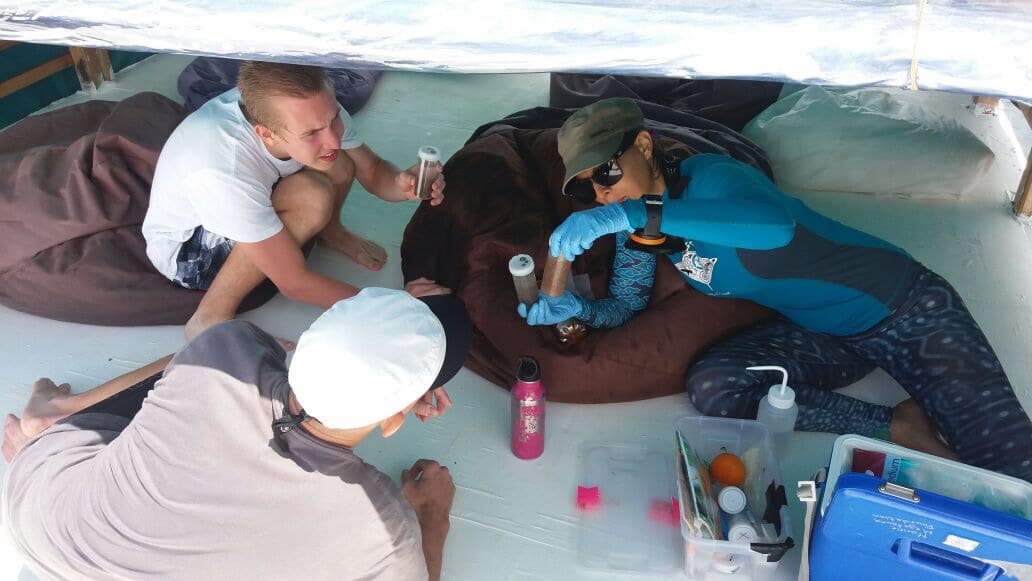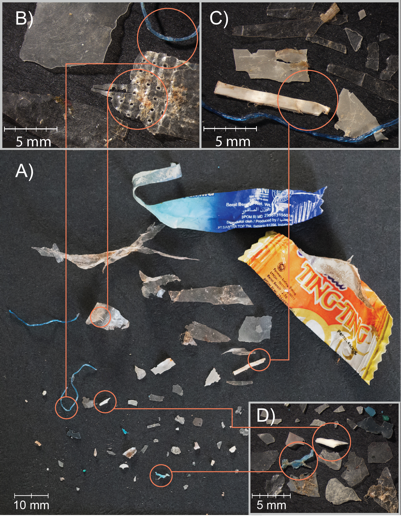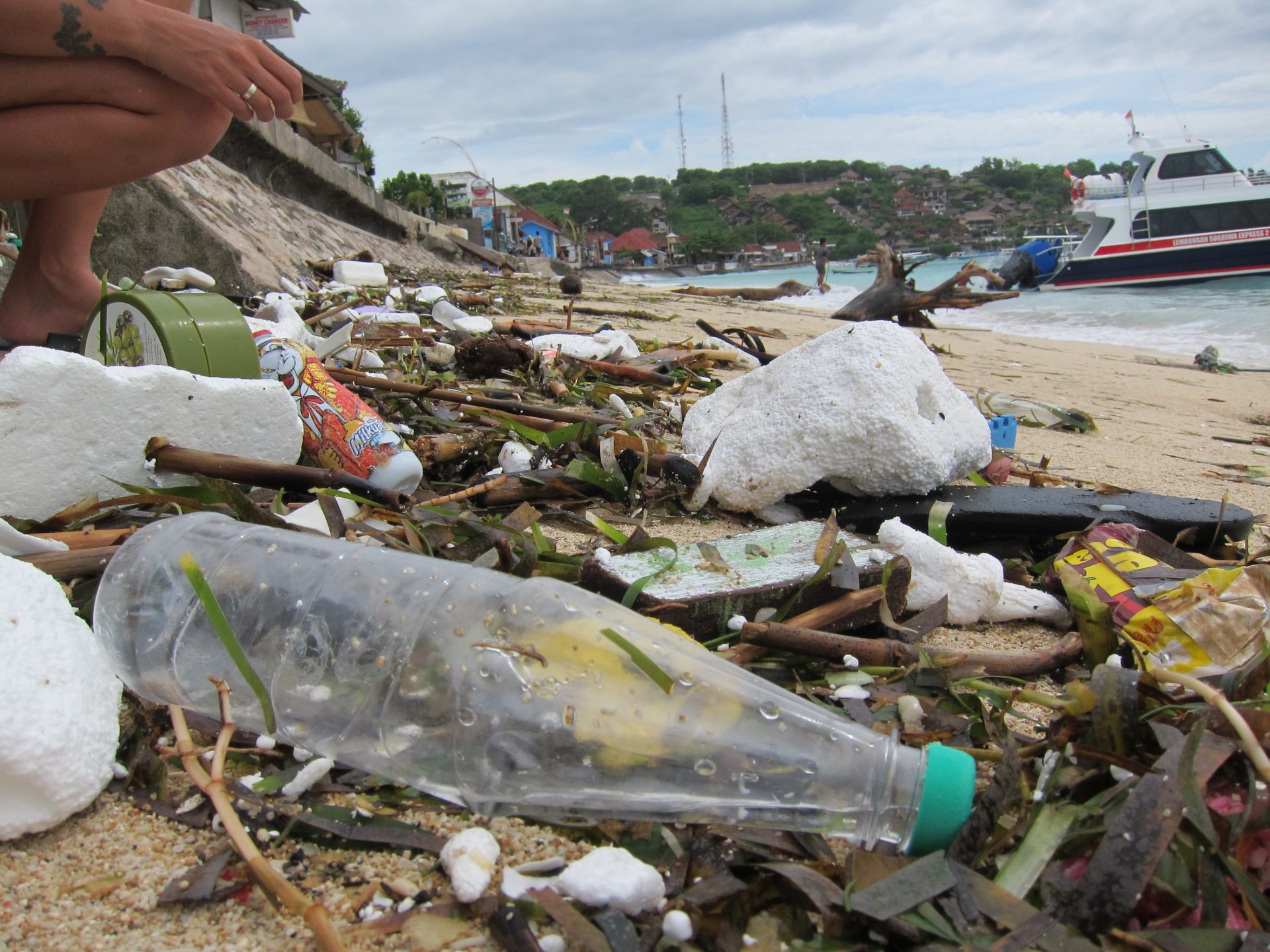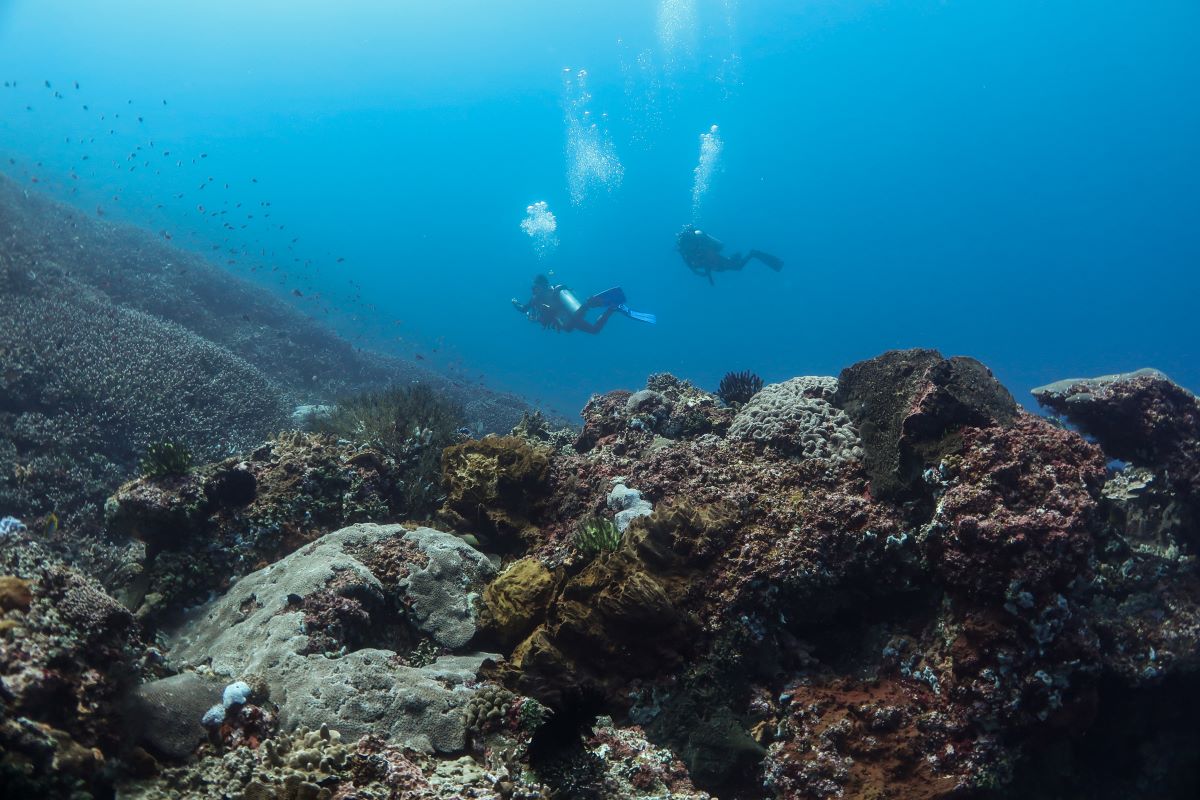News
Microplastics on the menu of Manta Rays and Whale Sharks

Plastics pollute Indonesian feeding grounds of plankton-feeding ocean giants…
Plastic pollution has a tremendous impact on marine life – and reef manta rays and whale sharks are not spared from it. These large filter-feeders swallow hundreds to thousands of cubic meters of plankton-filled water every day, and with it, tiny plastic pieces from broken down carrier bags and single-use packaging, a new study has found.
Marine biologists from the Marine Megafauna Foundation, Murdoch University (Australia) and Udayana University (Indonesia), estimated the amount of plastic particles present in the waters off Nusa Penida (Bali), Komodo National Park and East Java in Indonesia and, based on that, calculated how many pieces reef manta rays and whale sharks might be ingesting. These shark species sieve nutrient-rich water through their gills as they swim.
As manta rays and whale sharks spend a lot of time feeding in inshore surface waters where trash commonly aggregates, the researchers used a plankton net to trawl for plastics in the top 50 cm of the water column. They also counted any debris visible at the surface from the boat.

Elitza Germanov on boat – Marine Megafauna Foundation
Lead author Elitza Germanov, a researcher at the Marine Megafauna Foundation and PhD candidate at Murdoch University, said: “With time, plastics break down into smaller pieces called microplastics that large marine filter feeders might accidentally scoop up because they float among their prey.”
“Manta rays and whale sharks can ingest microplastics directly from polluted water or indirectly through the contaminated plankton they feed on,” she adds.

Plankton microplastics sampling – Marine Megafauna Foundation
The collaborative study, which is published today in the journal Frontiers in Marine Science, found that reef manta rays may ingest up to 63 pieces of plastic per hour of feeding in Nusa Penida and Komodo National Park. Whale sharks, which seasonally aggregate in Java, could be ingesting up to 137 pieces per hour.
Thin and bendable films from single-use bags and wrappers as well as hard fragments were the most prevalent plastics (over 50% combined). Of all plastic recorded, around 80% were small pieces of less than 5mm, so-called microplastics.
Manta ray poo and vomit also tested positive for plastics, which means that plastics are easily ingested when filter feeding and likely expose the animals to toxic chemicals and pollutants found in plastics while in their digestive system. These toxic substances can accumulate over decades and alter the hormones that regulate an animal’s metabolism, growth and development, and reproductive functions. Larger plastic particles can block nutrient absorption and cause damage to the digestive tract of animals.

Microplastics in manta poo (c) Elitza Germanov et al 2019
Neil Loneragan, Professor of Marine Ecology and Conservation at Murdoch University said: “It is difficult to assess how much plastic manta rays and whale sharks actually ingest because conventional methods used to study animal diets, such as stomach analysis, are unsuitable for threatened species like these.”
Manta rays and whale sharks are globally threatened species facing extreme pressures from overfishing. They are often caught incidentally in nets or become entangled in fishing lines.

Manta with plastic in Indonesia – Elitza Germanov, Marine Megafauna Foundation
Indonesia is currently ranked as the second worst plastic polluter in the world and many neighbouring countries within the Coral Triangle are among the top 10. This study found that plastic abundance was up to 44 times higher during the rainy season, with the largest seasonal effect observed in Nusa Penida.
Dr. I. Gede Hedrawan, an Indonesian plastics researcher from Bali’s Udayana University and an author on this study, said: “The seasonal variability in plastic pollution shows what a difference it would make to clean up river beds before the rainy season begins.” Local authorities could also prohibit any waste disposal in areas around water sources.
“We welcome Bali’s recent ban on single-use plastic bags, straws and take away containers, although the law is yet to reach its full effect and spread to smaller businesses,” he says.

Trash on beach Indonesia – Elitza Germanov, Marine Megafauna Foundation
It is vital to understand the effects of microplastic pollution on ocean giants since nearly half of the mobulid rays, two thirds of filter-feeding sharks and over one quarter of baleen whales are listed by the IUCN as globally threatened species and are prioritized for conservation. Previous studies found that baleen whales may swallow microplastic particles in the thousands every day.
“We now know that, through exposure to toxic substances, plastic contamination has the potential to further reduce the population numbers of these threatened animals because they reproduce slowly and have few offspring throughout their lives,” Germanov concluded.
As plastic production is projected to increase globally, future research should focus on coastal regions where pollution overlaps with the critical feeding and breeding grounds of these ocean giants. Many areas such as the Nusa Penida Marine Protected Area and Komodo National Park are biodiversity hotspots with significant marine tourism.

Trawling microplastic – Marine Megafauna Foundation
The field research was supported by the Ocean Park Conservation Foundation, PADI Foundation, Foundation FortUna, Mantahari Oceancare, Arenui Boutique Liveaboard, Current Junkies Liveaboard, Happy Days yacht, Scuba Junkie Komodo, and Wunderpus Liveaboard, and was carried out under a RisTek-Dikti (Indonesian Ministry of Research) permit.
The study by Elitza Germanov et al., titled ‘Microplastics on the menu: Plastics pollute Indonesian manta ray and whale shark feeding grounds’ is published in the journal Frontiers in Marine Science on 19 November 2019 and is available here: https://www.frontiersin.org/articles/10.3389/fmars.2019.00679/full
For further details, please see www.marinemegafauna.org or follow them on Twitter, Facebook and Instagram. For information about regional projects, follow the Marine Megafauna Foundation’s Southeast Asia Facebook page.
Marine Life & Conservation
IUCN Spotlights Green Fins at Bali Ocean Days 2025, Calling for Stronger Business Model in Marine Conservation

IUCN (International Union for Conservation of Nature) Global Ocean Director, Minna Epps, has spotlighted Green Fins Indonesia along with a call for stronger business models that sustain marine conservation. Speaking at the inaugural session of Bali Ocean Days 2025 held on 7-8 February, Epps emphasised the need for sustainable financing to support and scale marine conservation initiatives such as Green Fins.

Activities earlier in the week with the Coral Triangle Center in Sanur and Ceningan Divers in the Nusa Penida Marine Protected Area shaped the IUCN Ocean Director’s message at the conference and showcase, aligning with the theme of the blue economy and impact finance to sustain marine ecosystems.

“Tourism has such a big impact on marine biodiversity, and we need it to adhere to a certain code of conduct,” Epps said. “That is why through our funding facilities, we worked with The Reef-World Foundation advancing Green Fins so dive operators can become certified with standards. But this kind of initiative has been around for a long time and it’s also a tool used to improve [MPA management], but it needs to come with a business model. I also believe in market-based instruments to evolve this programme.”

IUCN’s visit is part of their Blue Natural Capital Financing Facility (BNCFF), which supports at least 21 projects around the world, building the business case for investing in the future of our ocean.
In Indonesia, the project supported by IUCN was developed in partnership with The Reef-World Foundation, the Coordinating Body on the Seas of East Asia (COBSEA) and the Coral Triangle Center, which serves as the local implementing organisation for Green Fins. The initiative engages marine tourism businesses through voluntary sustainability certification based on the only internationally recognised environmental standards for diving and snorkelling operations. Green Fins’ activities aim to reduce negative environmental impacts associated with marine tourism activities as well as improve the management of marine protected areas.

IUCN’s promotion of Green Fins in Bali Ocean Days signals the need for greater private sector engagement in marine conservation across Indonesia and beyond.
Investors, donors, marine tourism operators and stakeholders looking to support scalable marine conservation solutions are encouraged to explore opportunities with The Reef-World Foundation, the international coordinator of the Green Fins initiative. To learn more about sustainable marine tourism and how to get involved, visit www.reef-world.org.

About Reef-World
The Reef-World Foundation is a registered UK charity which delivers practical solutions for marine conservation around the world. The charity promotes the wise use of natural resources – particularly coral reefs and related ecosystems – for the benefit of local communities, visitors and future generations. It is dedicated to supporting, inspiring and empowering governments, businesses, communities and individuals around the world to act in conserving and sustainably developing coastal resources.
Reef-World leads the global implementation of the UN Environment Programme’s Green Fins initiative, which focuses on driving environmentally friendly scuba diving and snorkelling practices across the industry globally. As such, the charity provides low-cost and practical solutions to local and industry-wide environmental challenges associated with the marine tourism industry. It provides education and capacity-building assistance to empower environmental champions (within the diving industry, local communities, authorities and governments) to implement proven coastal resource management approaches.
Visit www.reef-world.org to learn more or follow them on Facebook, Instagram and X.
About Green Fins
Green Fins is a proven conservation management approach – spearheaded by The Reef-World Foundation in partnership with the UN Environment Programme – which leads to a measurable reduction in the negative environmental impacts associated with the marine tourism industry. The initiative aims to protect and conserve coral reefs through environmentally friendly guidelines that promote a sustainable diving and snorkelling tourism industry. It provides the only internationally recognised environmental standards for the diving and snorkelling industry and has a robust assessment system to measure compliance.
Green Fins encourages and empowers members of the diving industry to act to reduce the pressures on coral reefs by offering dive and snorkel companies practical, low-cost alternatives to harmful practices – such as anchoring, fish feeding and chemical pollution – as well as providing strategic training, support and resources. By reducing the local direct and indirect pressures tourism puts on coral reefs, it helps make corals healthier and more resilient to other stresses such as the effects of climate change. Look for the Green Fins logo when booking your next dive trip.Visit www.greenfins.net to learn more or follow the initiative on Facebook, Instagram and X.
News
Filming 360 in The Bahamas

In December 2024, the Shark Trust had a very special opportunity to film sharks and rays in The Bahamas. Frogfish Photography are the Bahamas Dive Ambassadors for the UK. And Caroline, Deputy Editor at Scubaverse, is the Marketing Manager at the Shark Trust. So, when the need arose to film footage of several species of shark and ray for a new Shark Trust project, The Bahamas seemed the perfect fit. A huge thank you is needed here to the Bahamas Ministry of Tourism. As they stepped in to fully support the trip both financially and practically. Ensuring that the filming expedition ran smoothly, and that we got as much time as possible in the water with sharks and rays, during the 10 day, 3 island trip.

The Bahamas is famous for its sharks and rays. Divers flock there to experience getting up close to a range of species. Our itinerary saw us visit Nassau, Bimini and Grand Bahama. It packed in as many in-water experiences as possible and had us dive, snorkel, and even take a submarine to experience them in a variety of different habitats and to capture them on film. We saw 148 sharks and rays from 8 different species (all of which have been logged on the Shark Trust Shark Log!).

But why were we there? The expedition was designed to fulfil the needs of two new projects being launched by the Shark Trust in 2025. The filming done underwater on this trip was the start of creating OneOcean360: A Shark Story. A new 360 immersive experience designed primarily for immersive domes and planetariums. The film will be the nearest experience to getting in the water with sharks and rays without getting wet! It will bring the world of sharks to an audience that may never get the chance to experience it first-hand. A Shark Story aims to deepen people’s understanding of sharks, uncovering and illustrating why they are so wonderful as well as being vital to marine ecosystems.
The film is being made in collaboration with Real Immersive. Also based in Plymouth, they have an immersive dome and are providing the technical expertise behind creating this unique experience. Reviewing the footage in the dome has been an invaluable part of the process. Both inspiring the team and allow us to refine the filming techniques to suit this immersive theatre.

You might imagine that we are using expensive cameras and even more expensive housings. But this is not the case. The entire project is being filmed using Insta360 X4 cameras. With only a few simple additions to the standard dive setup. The INON weight plate allowed us to attach this camera to a dive weight, set it down on sand or wreck, and then swim away and let the sharks be the stars. And the results are very exciting. The film will be ready this autumn. It will be accompanied by an educational pack for teachers to take away after school trips to see the film. Encouraging all those that see it to continue learning about these incredible animals.
You can support the creation of OneOcean360: A Shark Story by heading to the crowdfunder page and donating or selecting a reward.
https://www.crowdfunder.co.uk/p/a-shark-story
Read about the shark and ray dives we did on Nassau, Bimini and Grand Bahama in our next blog post coming soon on Scubaverse.
-

 Gear Reviews1 month ago
Gear Reviews1 month agoGear Review: SurfEars 4
-

 News3 months ago
News3 months agoSanta Divers take the Plunge for Charity
-

 Marine Life & Conservation2 months ago
Marine Life & Conservation2 months agoPaul Watson Released as Denmark Blocks Japan’s Extradition Bid
-

 Blogs2 months ago
Blogs2 months agoJeff Goodman Launches Underwater Moviemaker Course with NovoScuba
-

 News2 months ago
News2 months agoDive into Adventure: Limited Space Available for January Socorro Liveaboard Trip with Oyster Diving
-

 Blogs2 months ago
Blogs2 months agoExperience Malta and Gozo in 2025: A Paradise for Divers and Culture Lovers
-

 Blogs3 months ago
Blogs3 months agoThe Benefits of Underwater Photography Workshops
-

 Blogs3 months ago
Blogs3 months agoDiscover Curaçao with the Ultimate Dive Vacation Guide – 2024 DEMA Special Edition















